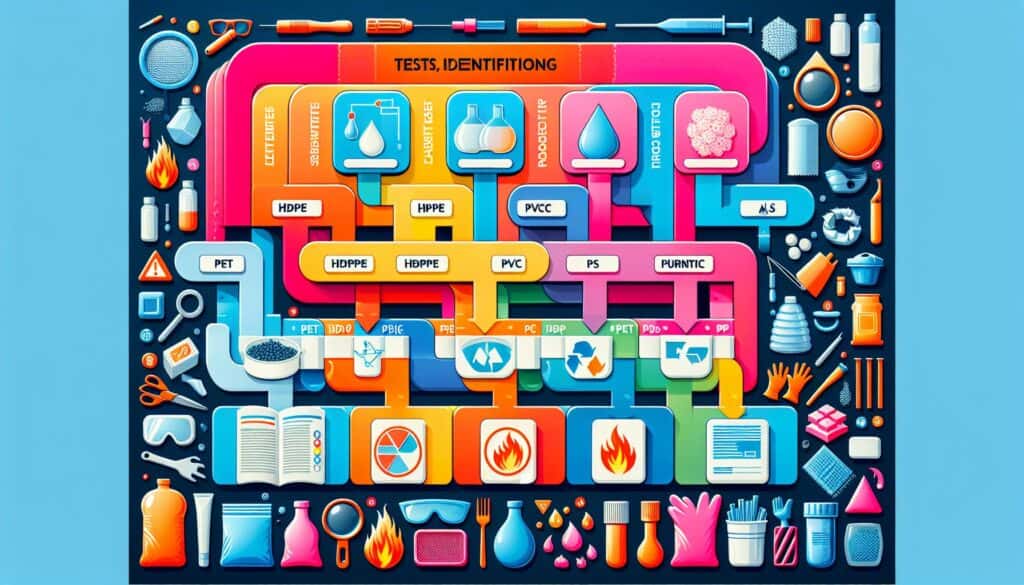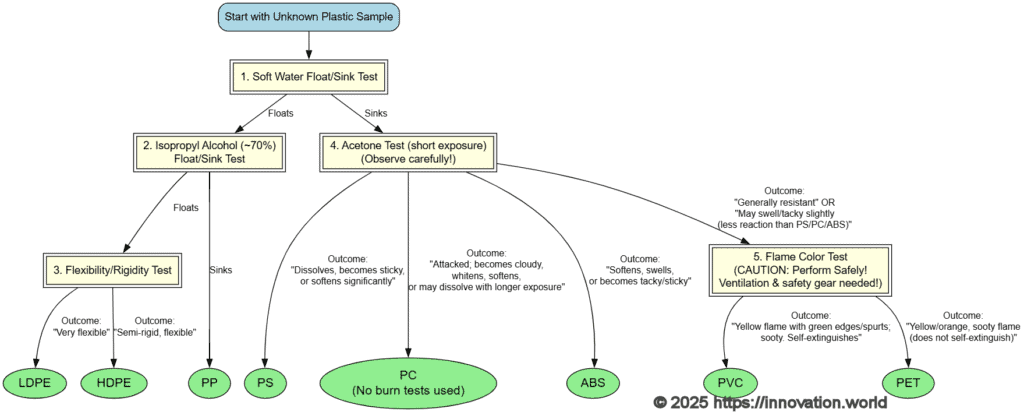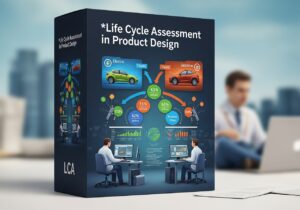
The most complete table to identify simple plastics.
Identifying the exact composition of an unknown plastic sample can seem daunting, but a series of simple, methodical tests performed at home can often successfully distinguish many common types.
By carefully observing characteristics like buoyancy in different liquids, flexibility, hardness, reaction to common solvents, and—with extreme caution—the flame and smoke produced when a tiny sample is burned, one can deduce the probable identity of materials such as PET, HDPE, PVC, LDPE, PP, PS, PC, and ABS. While not a substitute for laboratory analysis, these accessible techniques provide a practical means for initial material differentiation and general knowledge.
IMPORTANT SAFETY PRECAUTIONS:
– Any of these tests shall be performed by adults only –
- Burn Tests (Odor, Flame Color, Smoke Color, Dripping Behavior): these tests should ONLY be performed with EXTREME CAUTION. Use very small samples (matchstick head size), outdoors or under a well-ventilated fume hood. Wear safety goggles and heat-resistant gloves. Use tongs to hold the sample. NEVER inhale fumes directly; waft them carefully towards you after the flame is extinguished. Many البلاستيك and rubbers release toxic fumes.
Epoxy و PC fumes are dangerous and harmful. PTFE fumes are extremely dangerous even in very small quantities. ☠️ Do not burn any of these. ☠️ Perform other tests before to insure the plastic you’re testing is not any of these. If you’re unsure, do not burn it. - Tests with chemicals (Acetone, Isopropyl Alcohol): these are flammable and fumes can be irritating. Perform in a well-ventilated area, away from flames or sparks. Wear gloves and eye protection.
The most reliable initial identification method for اللدائن الحرارية is to look for the Resin Identification Code (RIC). Epoxy, EPDM, Nitrile, Silicone, and sometimes PC (which often falls under #7 OTHER) may not have a specific RIC or one that is easily visible.
| Test | PET / PETE (Polyethylene Terephthalate) | HDPE (High-Density Polyethylene) | PVC (Polyvinyl Chloride) | LDPE (Low-Density Polyethylene) | PP (Polypropylene) | PS (Polystyrene) | PC (Polycarbonate) | ABS (Acrylonitrile Butadiene Styrene) | PTFE (Polytetrafluoroethylene - e.g. Teflon™) | Epoxy Resin (Cured) | EPDM (Ethylene Propylene Diene Monomer Rubber) | Nitrile Rubber (NBR) | Silicone Rubber |
|---|---|---|---|---|---|---|---|---|---|---|---|---|---|
| Flexibility/Rigidity Test: Try to bend the plastic | Rigid | Semi-rigid, flexible | (Rigid PVC) Rigid; (Flexible PVC) Very flexible | Very flexible | Can be rigid or flexible (e.g., living hinges); generally stiff but bendable | (GPPS) Rigid and brittle. (HIPS) More impact resistant but still fairly rigid. | Rigid, very tough, high impact strength. | Rigid and tough | Flexible but strong. | Very rigid, hard. | Very flexible, rubbery elastomer. | Flexible, rubbery elastomer. | Very flexible, rubbery elastomer; can range from very soft to moderately firm. |
| Fingernail Scratch Test (Hardness): Attempt to scratch the plastic with a fingernail | More scratch-resistant than PE or PP, but can be scratched | Can be scratched by a fingernail | (Rigid PVC) Relatively scratch-resistant; (Flexible PVC) Easier to scratch | Scratches very easily | Can be scratched, but is harder than PE | (GPPS) Relatively easy to scratch. | Relatively scratch-resistant, but less so than glass. Can be scratched. | Relatively scratch-resistant | Soft, easily scratched. | Very scratch-resistant. | Can be scratched, but is resilient. | Can be scratched, resilient. | Relatively soft, can be scratched but is resilient. |
| Bending and Stress Whitening Test: Bend the plastic back and forth row | Rigid; can show some stress whitening before cracking | Shows significant stress whitening when bent | (Rigid PVC) Can show significant stress whitening | Very flexible; less prone to sharp whitening, deforms easily | Shows significant stress whitening; often used for "living hinges" | (GP PS) Brittle, snaps with little/no whitening. (HIPS whitens) | Tough; can be bent, may show some stress whitening before fracture, very impact resistant. | Tough, can show stress whitening before breaking. | Flexible but not prone to stress whitening in the same way as others; difficult to break by bending. | Rigid; will fracture, no stress whitening. | Very flexible, no stress whitening, returns to original shape. | Very flexible, no stress whitening, returns to original shape. | Very flexible, no stress whitening, returns to original shape. |
| Cutting Behavior Test | Harder to cut than PE/PP, can be brittle | Cuts smoothly and easily | (Rigid PVC) Can be cut, may show some resistance; (Flexible PVC) Cuts easily | Cuts very smoothly and easily | Cuts relatively easily and smoothly | Brittle, may snap or produce jagged edges/flakes when cut. | Tough to cut, requires effort but can be machined. | Tough to cut, requires effort, clean cut but may show some resistance. | Soft, cuts easily and cleanly (like hard cheese). | Hard to cut, may chip or fracture. | Cuts like rubber, requires a sharp blade. | Cuts like rubber. | Cuts cleanly like rubber. |
| Transparency/Opacity Observation | Often transparent (e.g., bottles); can be opaque (e.g., some food trays) | Typically translucent to opaque (e.g., milk jugs) | Can be transparent (flexible PVC films) to opaque (rigid pipes) | Thin films transparent; thicker sections translucent. Often milky. | Often translucent; can be opaque or clear (oriented PP film) | (GPPS) Transparent & brittle (CD cases). (HIPS) Opaque. (EPS/Styrofoam) Opaque. | Often highly transparent (e.g., lenses, CDs, glazing); can be opaque. | Generally opaque | Usually opaque white, can be slightly translucent in thin sections. | Can be transparent, translucent, or opaque. Often used as clear coatings or castings. | Typically opaque (usually black, but can be colored). | Typically opaque (often black, blue, or other colors for gloves). | Can be transparent (clear), translucent, or opaque. |
| Surface Feel/Texture Assessment | Smooth and rigid | Can feel waxy, often with a matte finish; semi-rigid | Smooth. Rigid PVC is hard; flexible PVC is pliable. | Waxy and soft; very flexible | Smooth, can sometimes feel slightly waxy; can be rigid or flexible (hinges) | Smooth and rigid (GPPS, HIPS). EPS is light & crumbly. | Smooth, rigid, hard. | Smooth, hard, and rigid; tough | Uniquely slippery, waxy feel; dense and flexible. | Smooth, hard, often glossy. | Rubbery, can be smooth or slightly textured. | Rubbery, can be smooth. | Rubbery, often smooth, can feel slightly "tacky" or "grippy" but not sticky like an adhesive. |
| Stretching Effect / Color Change | Becomes opaque or white when stretched/stressed (e.g., a dent) | Elongates considerably, can whiten or become opaque | (Rigid PVC) Whitens and deforms before breaking. (Flexible PVC) Stretches. | Stretches very easily, often becomes more opaque/milky | Elongates, often shows stress whitening, can form "hairs" or strings | (General Purpose PS) Brittle, snaps with little stretching. (HIPS may whiten) | Strong, less prone to stretching than PE; can whiten or show shear bands before fracture under high stress. | Strong, tough; may show some stress whitening before fracture | Very flexible but does not stretch much; retains shape. | Does not stretch; brittle. | Stretches significantly (elastomeric), returns to original shape, no significant color change. | Stretches, returns to original shape. | Stretches very well, returns to original shape. |
| Odor (after burning - waft CAUTIOUSLY) | Sweet, burnt sugar, slightly acrid/vinegar-like | Like burning paraffin wax (candle) | Sharp, acrid, chlorine/hydrochloric acid smell | Like burning paraffin wax (candle) | Acrid, like burning diesel/oil, sometimes slightly sweetish | Sweetish, styrene monomer ("marigold flower" or "gassy" smell) | ☠️ | Acrid, burnt rubber/styrene-like | ☠️☠️☠️ | ☠️ | Smells like burning rubber, slightly waxy or paraffinic. | Acrid, pungent, like burning rubber with a distinct "nitrile" or "ammonia-like" undertone. | Very little odor, or a faint sweetish smell. Does NOT smell like burning organic rubber. Produces white, silica ash. |
| Flame Color | Yellow/orange, somewhat sooty flame | Blue base, yellow tip; not very sooty | Yellow flame with green edges/spurts; sooty. Self-extinguishes when flame removed. | Blue base, yellow tip; not very sooty | Yellow tip, blue base; may have some soot | Yellow, very sooty flame; orange sparks possible | ☠️ | Yellow, sooty flame, with blue edges | ☠️☠️☠️ | ☠️ | Yellow, sooty flame. | Yellow, sooty. | Burns with difficulty, may give a bright flame or just char. Flame color less distinct. |
| Dripping Behavior (during burning) | Melts and drips; drips may form "legs" or strings, may not easily ignite. | Drips readily; drips are flammable and continue to burn. | Softens and chars, generally does not drip. | Drips readily; drips are flammable and continue to burn. | Drips readily; drips are flammable and continue to burn. | Softens, may drip; produces significant soot. | ☠️ | Softens, blackens, may form stringy drips. | ☠️☠️☠️ | ☠️ | Melts and drips, drips may burn. | Melts, drips, drips may burn. | Does not melt or drip like thermoplastics; chars and turns into a white silica ash. |
| Smoke Color | Blackish, sooty | Little to no smoke, or light/white smoke | Blackish, acrid, dense | Little to no smoke, or light/white smoke | Some blackish smoke, less than PS | Dense, black, very sooty | ☠️ | Dense, black, sooty | ☠️☠️☠️ | ☠️ | Black, sooty. | Black, sooty. | White or very light smoke (if any when burning properly, mainly ash). |
| Soft Water Float/Sink Test | Sinks | Floats | Sinks | Floats | Floats | Sinks (solid PS). EPS Floats. | Sinks. | Sinks | Sinks | Sinks. | Usually Sinks (if compounded); pure EPDM may float. | Sinks. | Sinks. |
| Saturated Saltwater Float/Sink Test (Highly Concentrated) | Sinks | Floats | Sinks | Floats | Floats | Floats (solid PS). EPS Floats. | Sinks. | Floats | Sinks | Sinks. | Usually Sinks (if compounded). | Sinks. | Sinks. |
| Isopropyl Alcohol (~70%) Float/Sink Test | Sinks | Floats | Sinks | Floats | Sinks (or neutrally buoyant) | Sinks (solid PS). EPS Floats. | Sinks. | Sinks | Sinks | Sinks. | Depends on compounding (may float or sink). | Sinks. | Sinks. |
| Bending and Stress Whitening | Rigid; can show some stress whitening before cracking | Shows significant stress whitening when bent | (Rigid PVC) Can show significant stress whitening | Very flexible; less prone to sharp whitening, deforms easily | Shows significant stress whitening; often used for "living hinges" | (GP PS) Brittle, snaps with little/no whitening. (HIPS whitens) | Tough; can show some stress whitening or shear banding before fracture. | Tough, can show stress whitening before breaking. | Flexible but not prone to stress whitening in the same way as others; difficult to break by bending. | Rigid; will fracture, no stress whitening. | Very flexible, no stress whitening. | Very flexible, no stress whitening. | Very flexible, no stress whitening. |
| Acetone Test (short exposure, e.g., 20-30 seconds) | Generally resistant; may slightly cloud with prolonged exposure | Resistant | May swell or become slightly tacky; generally not dissolved quickly | Resistant | Resistant | Dissolves, becomes sticky, or softens significantly | Attacked; becomes cloudy, whitens, softens, or may dissolve with longer exposure. | Softens, swells, or becomes tacky/sticky | Extremely resistant to virtually all solvents, including acetone. | Generally resistant once fully cured; some may soften slightly with prolonged exposure. | Generally good resistance, may swell slightly with prolonged exposure but not dissolve. | Poor resistance; swells significantly, softens, or degrades/dissolves. | Generally good resistance; may cause temporary slight swelling in some formulations but usually recovers. Not dissolved. |
| Resin Identification Code (RIC) | #1 | #2 | #3 | #4 | #5 | #6 | #7 (Often "OTHER") | #7 (Often "OTHER") | غير متاح | غير متاح | غير متاح | غير متاح | غير متاح |
© 2025 https://innovation.world
Notes:
- Saturated Saltwater: a highly concentrated solution will have a higher density than a typical ~3.5% seawater solution.
- Isopropyl Alcohol (~70%): the density of this solution is lower than water.
- “Solid PS” refers to non-expanded polystyrene. Expanded Polystyrene (EPS/Styrofoam) will float in all liquids due to its trapped air.
Results, especially the ones related to flame, can vary based on specific formulations, additives (colorants, fillers, plasticizers, UV inhibitors, etc.), copolymers, and manufacturing processes. The inclusion of Fiber Glass (FB) changes both the stiffness and the aspect.
This table is for general guidance. For critical applications or complex/blended materials, professional laboratory analysis is necessary.
Plastics Identification Test Tree









